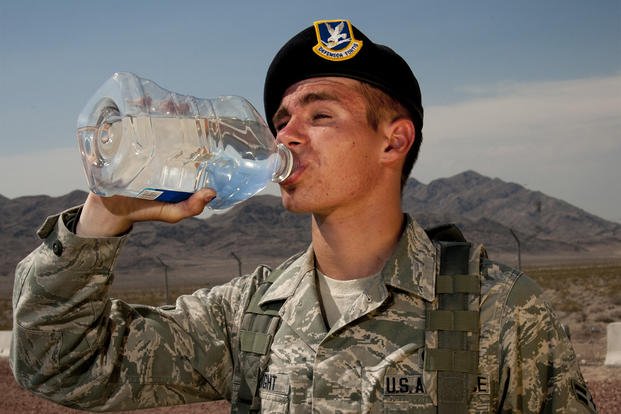Training in the summer takes some special consideration, especially if you live in a hot and humid environment like the South, East Coast and Midwest. However, training in arid and hot environments like the Southwest and Western U.S. requires the same considerations. Drier climates actually can be more dangerous as you do not sweat to stay cool (it just evaporates almost instantly) -- but you will notice salt stains on clothing, just the same.
Here is a question from a trainer down in Charleston, who needed some ideas other than the typical "stay well-hydrated, avoid the heat of the day, etc. ..."
Stew, I train mostly fighters. I believe outdoor training-PT and running/rucking for regular Marines gets red-flagged here around 92 degrees F. Do you have any thoughts on training in the heat for elite athletes, like SEALs or Marine Force Recon? My question is limited to upper limits of training in the heat. I train athletes, all kinds, for max performance, and then some for specific conditions, like altitude or heat as an event approaches. I don't want a fighter overwhelmed by heat in the ring or on the field, but I want them performing like they trained in ideal conditions. Any advice?
I have found through experience and studies that half of fatigue is related to body heat, so if you can keep the fighter's body heat down, the better they will be -- no matter what the temperature is outside. We train year-round, but in the summer, we get most of our workouts done in the early morning.
It is always bearable on the heat scale, but we do a few acclimatizing workouts later in the day to get used to 90+ degrees. Eventually, if you do it right, your fighters will say, "Hey, it is only going to be 89 degrees today; better bring a sweater." I used to think the SEAL instructors were just putting us in the water as part of the cold-water torture program to get us to quit. But I remember so many times that after a long beach run in the heat of the day, getting into the cold Pacific Ocean was reinvigorating once we were finished. It did not seem like surf torture then.
As you know, hydration is the key before, during and after a workout in the heat. And when profusely sweating (or producing salt stains), you need the salts (electrolytes) even more than normal. Sweating is the key to staying cool, but if in arid environments or humid as well, you need to get them soaking wet in a pool, lake, river or with a water hose. That really helps, too, and almost gives the students a second wind.
We typically will work out in the heat -- feel completely burned out and very hot, then jump in the pool to start a swim workout. After about 3-4 minutes of cooling down, all members are ready to go again almost as if they were fresh and did not get hot prior. Like I said, half of fatigue is body heat. Stay cool, hydrated and well-fueled, and you can go all day.
So our heat-busting workouts look like this:
Limit time to one hour in the heat/humidity, finding shade as much as possible to do PT/water breaks, etc.
My Spec Ops groups and I typically will run 5-6 miles, mixed in with calisthenics of pull-ups, push-ups, abs and squats for that 45-60 minutes. Then go to the pool and continue with swim PT.
Hydration, electrolytes and carbs can be added now. Jump in the pool and cool down for 4-5 minutes.
Typical swim PT workout:
Repeat 10-15 times.
-
100-meter swim
-
Push-ups 20-30
-
Plank pose for remainder of two-minute push-up set
-
Rest with abs of choice one minute
Prior to getting in the water, we do not feel like doing part two of this workout, but after that pool cooldown, it really helps.
So in a nutshell, keep them cool with some form of water (not just drinking water but some form of getting soaked). When you can, PT in the shade. Start harder workouts in the early morning, but as the group gets used to the morning heat, push to later in the morning and into the early afternoon. Always follow hot workouts with a way to soak your body completely and find a way to cool down.
Special consideration for air quality. Often in the heat of the day, if the smog pollution and ozone levels are high, it can be harmful to train in the bad air. Upper-respiratory infections can follow quickly; as "they say," it is like smoking a pack of cigarettes when you run in poor air quality so it depends on your geographical location as well.
Stew Smith is a former Navy SEAL and fitness author certified as a Strength and Conditioning Specialist (CSCS) with the National Strength and Conditioning Association. Visit his Fitness eBook store if you're looking to start a workout program to create a healthy lifestyle. Send your fitness questions to stew@stewsmith.com.
Want to Learn More About Military Life?
Whether you're thinking of joining the military, looking for fitness and basic training tips, or keeping up with military life and benefits, Military.com has you covered. Subscribe to Military.com to have military news, updates and resources delivered directly to your inbox.




















